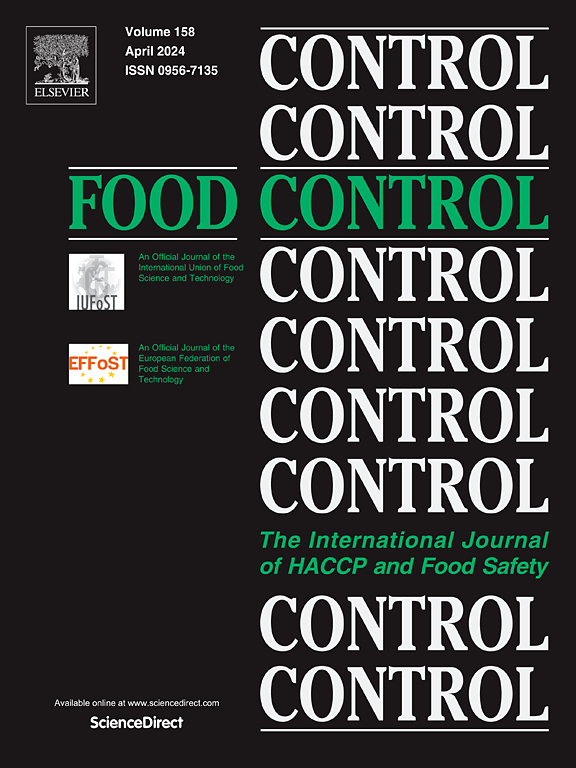通过细胞内稳态和脂质分析揭示欧姆加热对蜡样芽孢杆菌孢子的作用机制
IF 5.6
1区 农林科学
Q1 FOOD SCIENCE & TECHNOLOGY
引用次数: 0
摘要
蜡样芽孢杆菌孢子可引起食品腐败,导致食源性疾病和重大经济损失。欧姆加热(OH)是一种新兴的替代性热处理技术,广泛用于食品的巴氏杀菌或灭菌,具有灭活孢子的潜力。本研究结果表明,欧姆加热可有效灭活蜡样芽孢杆菌孢子。为了阐明 OH 对蜡样芽孢杆菌孢子的灭活机制,研究人员对孢子特征、孢子膜完整性、细胞内物质浓度和孢子脂质组成等多项理化指标进行了调查。在处理过程中,OH 处理既不会产生 H2O2,也不会导致孢子中的脂质氧化。油浴加热(OB)和 OH 处理都会影响过氧化氢酶、谷胱甘肽过氧化物酶、ATP 酶、Na+/K+-ATP 酶和 Ca2+/Mg2+-ATP 酶的活性,这表明孢子的细胞内平衡受到了破坏。此外,在 OB 和 OH 处理后,还观察到 K+、Ca2+ 和 Mg2+ 从孢子中渗漏,内膜流动性下降。然而,在 10 V/cm 和 50 Hz 的条件下进行 OH 处理,阳离子渗漏最小,过氧化氢酶活性损伤更明显。与 OB 处理相比,OH 处理对孢子的脂质组成和代谢途径的影响更为显著,尤其是对主要成膜磷脂和甘油磷脂代谢的影响。本研究从多个角度全面了解了 OH 对孢子的灭活机理,促进了 OH 在食品杀菌中应用的理论进展。本文章由计算机程序翻译,如有差异,请以英文原文为准。
Revealing the mechanism of ohmic heating against Bacillus cereus spores through intracellular homeostasis and lipid analysis
B. cereus spores can cause food spoilage, leading to food-borne illness and significant economic losses. Ohmic heating (OH) is an emerging and alternative thermal processing technique widely used for pasteurizing or sterilizing food, with the potential to inactivate spores. The results of this study indicated that OH can effectively inactivate B. cereus spores. To elucidate the inactivation mechanism of B. cereus spores by OH, several physicochemical indices were investigated, including spore characteristics, spore membrane integrity, intracellular substance concentration, and spore lipid composition. OH treatment neither produced H2O2 during processing nor caused lipid oxidation in spores. Both oil bath heating (OB) and OH treatments affected catalase, glutathione peroxidase, ATPase, Na+/K+-ATPase, and Ca2+/Mg2+-ATPase activity, suggesting a disruption in the intracellular homeostasis of the spores. Additionally, K+, Ca2+, and Mg2+ leakage from spores, and a decrease in inner membrane fluidity was observed following OB and OH treatments. However, OH treatment at 10 V/cm and 50 Hz resulted in minimal cation leakage and more pronounced catalase activity damage. OH treatments had a more significant impact on the lipid composition and metabolism pathways of spores than OB treatment, particularly concerning major membrane-forming phospholipids and glycerophospholipid metabolism. This study provides a comprehensive understanding of the OH inactivation mechanism on spores from various perspectives, promoting theoretical advancement of OH application in food sterilization.
求助全文
通过发布文献求助,成功后即可免费获取论文全文。
去求助
来源期刊

Food Control
工程技术-食品科技
CiteScore
12.20
自引率
6.70%
发文量
758
审稿时长
33 days
期刊介绍:
Food Control is an international journal that provides essential information for those involved in food safety and process control.
Food Control covers the below areas that relate to food process control or to food safety of human foods:
• Microbial food safety and antimicrobial systems
• Mycotoxins
• Hazard analysis, HACCP and food safety objectives
• Risk assessment, including microbial and chemical hazards
• Quality assurance
• Good manufacturing practices
• Food process systems design and control
• Food Packaging technology and materials in contact with foods
• Rapid methods of analysis and detection, including sensor technology
• Codes of practice, legislation and international harmonization
• Consumer issues
• Education, training and research needs.
The scope of Food Control is comprehensive and includes original research papers, authoritative reviews, short communications, comment articles that report on new developments in food control, and position papers.
 求助内容:
求助内容: 应助结果提醒方式:
应助结果提醒方式:


